Difference between revisions of "Pocket Kodak No. 1 series II"
m (→Images) |
m (Adjusted pic size) |
||
| (26 intermediate revisions by 12 users not shown) | |||
| Line 1: | Line 1: | ||
| − | + | {{Flickr_image | |
| − | + | |image_source=http://www.flickr.com/photos/50678983@N00/168465073/in/pool-camerawiki | |
| − | + | |image=http://static.flickr.com/48/168465073_2118b92c21_n.jpg | |
| − | The | + | |image_align=right |
| − | + | |image_text=Pocket Kodak No. 1 series II | |
| − | + | |image_by=Dries van den Elzen | |
| − | + | |image_rights=wp | |
| − | + | }} | |
| − | + | ||
| − | + | The '''Pocket [[Kodak]] No. 1 series II''' is a folding 120 film camera made from 1922 to 1931.<ref>{{McKeown12}} Page 514.</ref> It uses 120 [[autographic]] roll film that was produced by Eastman Kodak between 1914 and 1934, you can also use standard 120 film. It has exposure advice; select aperture and lighting conditions ''dull, gray, clear'' or ''brilliant''. At the shown aperture "figures indicate required exposure" as it states on the lever. | |
| − | + | ||
| − | + | * '''Type:''' 6×9 cm or 2¼×3¼" [[folding]] camera. | |
| − | The camera was | + | * '''Film Type:''' 120 [[Autographic]] Roll Film, can use standard [[120]] film as well |
| − | == Viewfinder == | + | * '''Lens:''' [[Kodak]] [[Anastigmat]] 108mm f/7.7 |
| − | + | * '''Diaphragm:''' f/7.7 continuously adjustable to f/32 | |
| − | + | * '''Shutter:''' Diomatic No. 0 - Manually cocked | |
| − | + | * '''Shutter Speeds:''' Bulb, Time, 1/10, 1/50, 1/100 and 1/200th | |
| + | * '''Viewfinder:''' Waist level finder | ||
| + | * '''Film Loading:''' Manual - removable back | ||
| + | * '''Film Transport:''' Manual wind knob/lug with red window | ||
| + | * '''Tripod Socket:''' Standard 1/4" | ||
| + | |||
| + | The camera was designed to use A120 film. To benefit from this [[autographic]] feature, a stylus with an Art Deco look was included (just above the window). Very often the stylus is lost on cameras you find at photographica fairs. On the back of the camera, you find the obvious red windows used for frame counting. On this camera, a little advice was imprinted in the black leather: ''use film No A120''. Nowadays, all you can use is simple 120 film. | ||
| + | {{br}} | ||
| + | === Viewfinder === | ||
The finder is a prism that, when looked at from a distance, gives you an idea of framing. The prism can be put in a horizontal or vertical position, so composing can be done by looking into it from above or from the side of the camera. The prism field is shows swiss cross for ''portrait'' or ''landscape'' pictures. | The finder is a prism that, when looked at from a distance, gives you an idea of framing. The prism can be put in a horizontal or vertical position, so composing can be done by looking into it from above or from the side of the camera. The prism field is shows swiss cross for ''portrait'' or ''landscape'' pictures. | ||
| − | == | + | {|class="plainlinks" align="left" |
| − | < | + | |- |
| − | [http://www.flickr.com/photos/50678983@N00/168465075/in/pool- | + | || [http://www.flickr.com/photos/50678983@N00/168465076/in/pool-camerawiki http://static.flickr.com/56/168465076_c9cba33010_t.jpg] |
| − | + | || [http://www.flickr.com/photos/50678983@N00/231843070/in/pool-camerawiki http://static.flickr.com/84/231843070_0de054e65a_t.jpg] | |
| − | + | || [http://www.flickr.com/photos/50678983@N00/231843069/in/pool-camerawiki http://static.flickr.com/73/231843069_63e0ac648e_t.jpg] | |
| + | || [http://www.flickr.com/photos/50678983@N00/231843068/in/pool-camerawiki http://static.flickr.com/84/231843068_e36b22e0fb_t.jpg] | ||
| + | |- | ||
| + | | colspan=4 align="center" | The ''viewfinder'' with the ''portrait'' orientation or a ''landscape'' composition. | ||
| + | |- | ||
| + | | colspan=4 align="center" | <small>images by {{image author |Dries van den Elzen}}</small> {{with permission}} | ||
| + | |} | ||
| + | {{br}} | ||
| + | |||
| + | |||
| + | {|class="plainlinks" align="left" | ||
| + | |- | ||
| + | || [http://www.flickr.com/photos/50678983@N00/168465074/in/pool-camerawiki http://static.flickr.com/44/168465074_e072bae76b_m.jpg] | ||
| + | || [http://www.flickr.com/photos/50678983@N00/168465072/in/pool-camerawiki http://static.flickr.com/71/168465072_2257313d6d_m.jpg] | ||
| + | || [http://www.flickr.com/photos/50678983@N00/168465075/in/pool-camerawiki http://static.flickr.com/64/168465075_ada56baa05_m.jpg] | ||
| + | || [http://www.flickr.com/photos/50678983@N00/168458783/in/pool-camerawiki http://static.flickr.com/69/168458783_101c14648d_m.jpg] | ||
| + | |- | ||
| + | | colspan=4 align="center" | <small>images by {{image author |Dries van den Elzen}}</small> {{with permission}} | ||
| + | |} | ||
| + | {{br}} | ||
| + | ==Notes== | ||
| − | < | + | <references/> |
| − | == | + | ==Links== |
| − | + | *[https://www.butkus.org/chinon/kodak/kodak_pocket_series_ii_1_1a/kodak_pocket_series_1_1a.htm Pocket Kodak No. 1 series II user manual] at [https://www.butkus.org/chinon/ Butkus.org] | |
| − | [ | + | *[http://www.collection-appareils.fr/x/html/page_standard.php?id_appareil=11970 No.1 Pocket series II], [http://www.collection-appareils.fr/x/html/page_standard.php?id_appareil=11971 No.1 Pocket series II (made in Canada)] on [http://www.collection-appareils.fr/general/html/francais.php www.collection-appareils.fr] by Sylvain Halgand (in French) |
| − | |||
| − | [http://www. | ||
| − | [http://www. | ||
| − | [http://www. | ||
| − | |||
[[Category: 6x9 viewfinder folding]] | [[Category: 6x9 viewfinder folding]] | ||
[[Category: Kodak]] | [[Category: Kodak]] | ||
[[Category: P]] | [[Category: P]] | ||
| + | [[Category: 1922]] | ||
| + | __NOTOC__ | ||
Latest revision as of 05:10, 20 July 2022
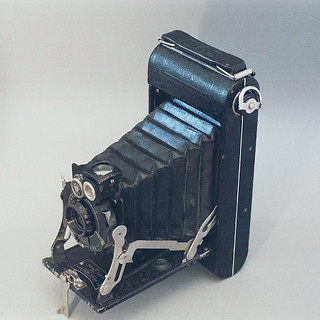
|
| Pocket Kodak No. 1 series II image by Dries van den Elzen (Image rights) |
The Pocket Kodak No. 1 series II is a folding 120 film camera made from 1922 to 1931.[1] It uses 120 autographic roll film that was produced by Eastman Kodak between 1914 and 1934, you can also use standard 120 film. It has exposure advice; select aperture and lighting conditions dull, gray, clear or brilliant. At the shown aperture "figures indicate required exposure" as it states on the lever.
- Type: 6×9 cm or 2¼×3¼" folding camera.
- Film Type: 120 Autographic Roll Film, can use standard 120 film as well
- Lens: Kodak Anastigmat 108mm f/7.7
- Diaphragm: f/7.7 continuously adjustable to f/32
- Shutter: Diomatic No. 0 - Manually cocked
- Shutter Speeds: Bulb, Time, 1/10, 1/50, 1/100 and 1/200th
- Viewfinder: Waist level finder
- Film Loading: Manual - removable back
- Film Transport: Manual wind knob/lug with red window
- Tripod Socket: Standard 1/4"
The camera was designed to use A120 film. To benefit from this autographic feature, a stylus with an Art Deco look was included (just above the window). Very often the stylus is lost on cameras you find at photographica fairs. On the back of the camera, you find the obvious red windows used for frame counting. On this camera, a little advice was imprinted in the black leather: use film No A120. Nowadays, all you can use is simple 120 film.
Viewfinder
The finder is a prism that, when looked at from a distance, gives you an idea of framing. The prism can be put in a horizontal or vertical position, so composing can be done by looking into it from above or from the side of the camera. The prism field is shows swiss cross for portrait or landscape pictures.
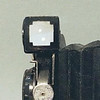
|

|

|

|
| The viewfinder with the portrait orientation or a landscape composition. | |||
| images by Dries van den Elzen (Image rights) | |||
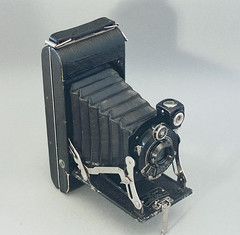
|
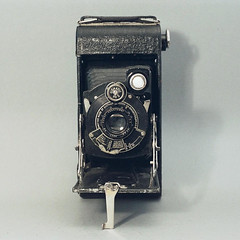
|
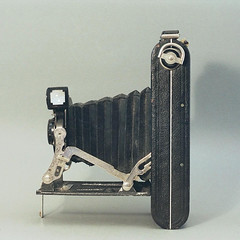
|
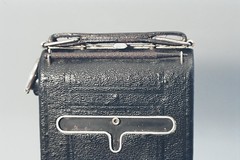
|
| images by Dries van den Elzen (Image rights) | |||
Notes
- ↑ McKeown, James M. and Joan C. McKeown's Price Guide to Antique and Classic Cameras, 12th Edition, 2005-2006. USA, Centennial Photo Service, 2004. ISBN 0-931838-40-1 (hardcover). ISBN 0-931838-41-X (softcover). Page 514.
Links
- Pocket Kodak No. 1 series II user manual at Butkus.org
- No.1 Pocket series II, No.1 Pocket series II (made in Canada) on www.collection-appareils.fr by Sylvain Halgand (in French)